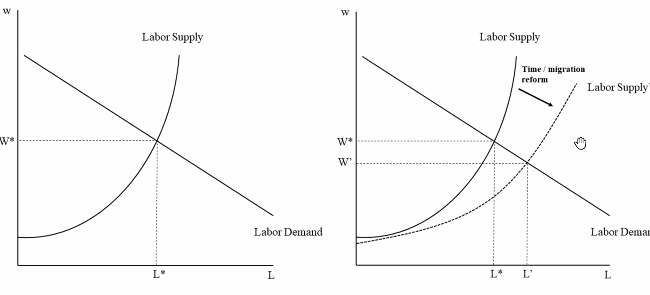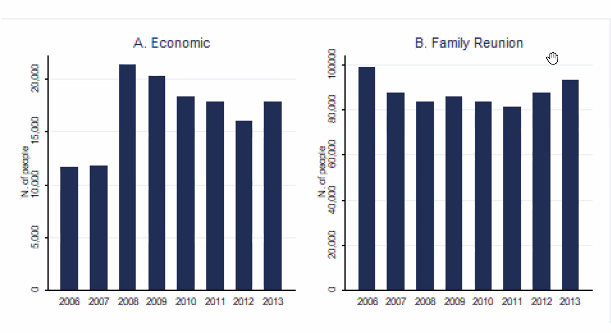Do skilled migrants compete with native workers? Analysis of a selective immigration policy
Seminar notes
Disclaimer: These notes are circulated for the joy of sharing research that I find interesting and stimulating. I hope that they can be helpful to you as well. The present document has been reviewed by the author. However, it could contain errors and/or approximations. Before citing the reported results, please, make sure to check the latest publicly available release.
Do skilled migrants compete with native workers? Analysis of a selective immigration policy
Motivation
- High-skilled migration central in public debate
- Long list of selective immigration policies (CAN, AUS, USA, etc)
- Recent changes: USA freeze H-1B “as a way to protect domestic jobs”
Related Literature
- Canonical model: the labor demand is downward sloping -> migration shock depress wages of similar workers
- Empirical findings: fail to find large negative effects (aka “mild wage effect”). Various explanations:
- Cells delineating competitive space in terms of education/jobs are too large
- Migrants suffer skill downgrading when they migrate
- Natives switch to better occupations
What/how she does?
- Research question: What is the impact of a high skill migration shock on employment and wages of domestic workers?
- Actual empirical approach: looks at a 2008 French reform easing the hiring of immigrant employees within a list of tech occupations for non EU migrants.
- Causality: Use this natural experiment to study the mechanisms behind mild wage effects
Findings
- Employment level
- +1.4% in employment level in the targeted occupations
- Hires
- Migrant hires in reform occupations: +50%
- Natives unaffected
- Wages
- average wages: -3.6% migrant vs natives unaffected
- hiring wages: -14.6% migrant vs -7.5% for natives
- Channels
- Statistical support for: the technological story (natives and migrants are actually not perfect substitutes in terms of skills) and bargaining power (lower bargaining power for migrants)
- No clear support for: composition effect (natives flying to other occupations) skill downgrading
Conceptual framework
- Standard model of supply and demand
- Only specificity: the supply and demand curve meet at a point where labor supply is mostly inelastic - reflects tight market

-> We expect migration to affect the elasticity
Data
- Employer employee data
- Panel data
Identification
-
Treated group: occupation in the list of 30 open to all non EU
-
Control group: extended list of occupations with tightness above mean but not treated
Results
Employment
+1.4% in eq. employment (level) in targeted occupations
Hiring
+50% number of migrants hired
+16% share of migrants in new hires
+15% proba hiring a migrant
no significant effect on native hires
Wages
-3.6% on migrant average wages
No significant effect on native average wages
-14.5% in migrant hiring wages
-6.9% on native hiring wages
Channels
- Technology? Imperfect substitution in actual production -> would mean that task diversity should make the effect larger
- Differences in bargaining power through outside options
Composition effects through native flightSkill downgrading
Both the tech and bargaining power seem to be part of the story - cannot say which effect is larger though.
Conclusion
- Increased lastingly migrant hires in targeted jobs w/o harming native employment -> tightness reduced
-
Negative pressure on wages is twice larger on migrants than natives
- Channels: imperfect substitution (technology story) & difference in bargaining power
Appendix: The 2008 French reform
Set-up
- Abolishes 2 major requirements to migrant hiring:
- Proof of prior search of a resident
- Tightness of the labor market (at the occupation level)
- Introduced in 2008
- 30 tight occupations -> no clear threshold though (key for identification)
- Different sub-sample across regions
- Part of a larger reform
Reaction

Tightness indicator
- job offers/job seekers
- evolution of job offers
- evolution of job seekers
- turnover rate
- share of long term contracts in job offers